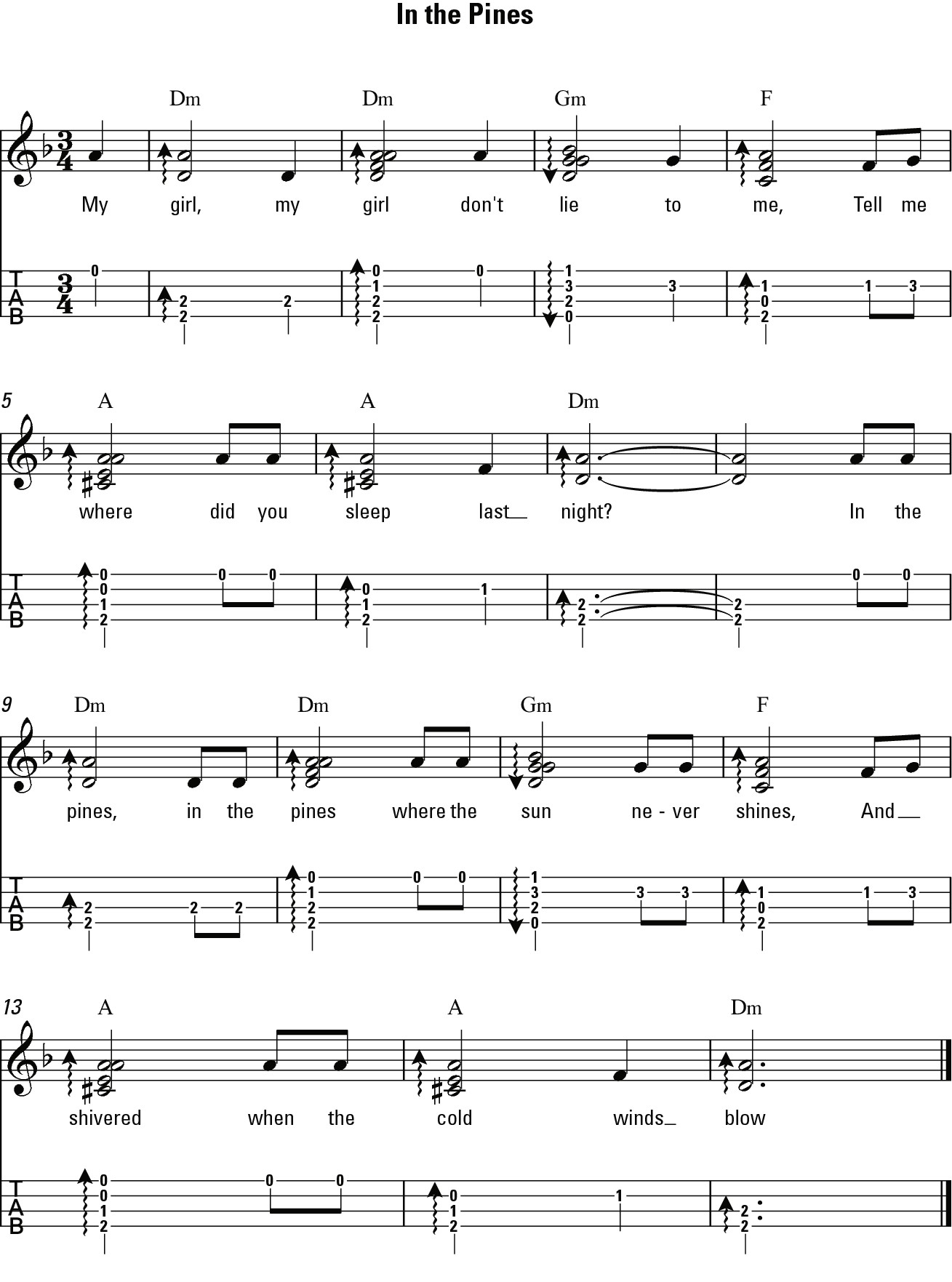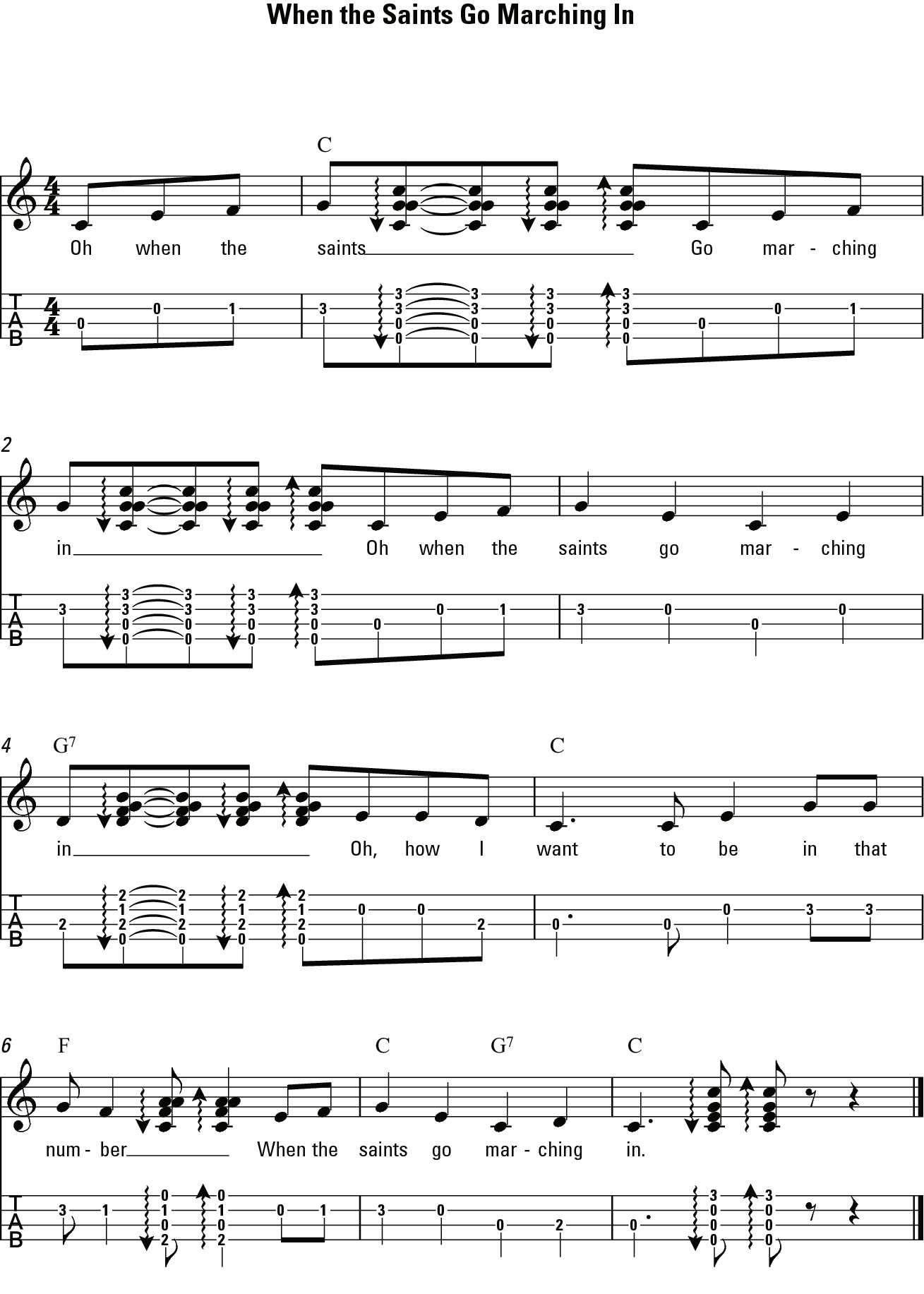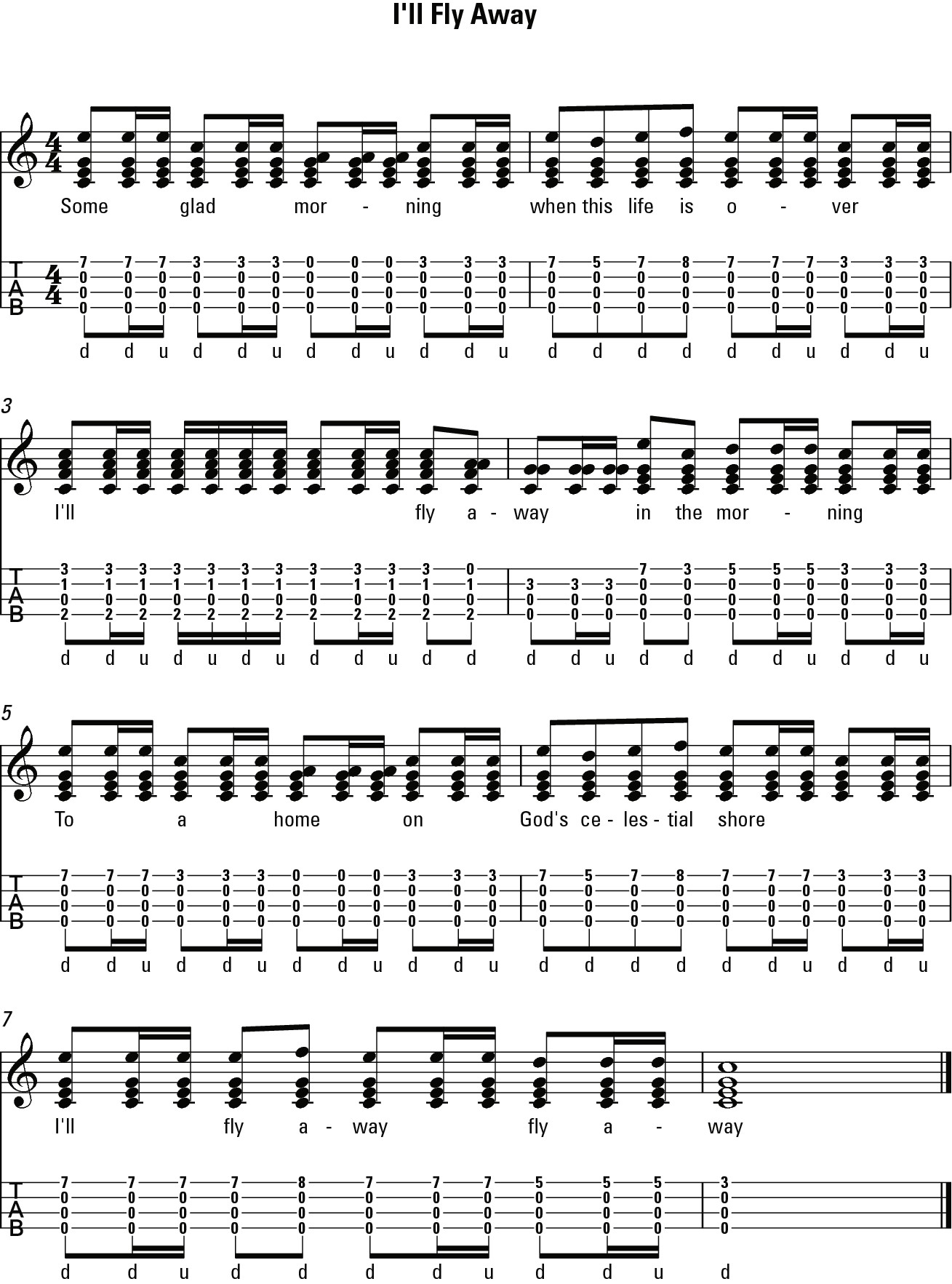Ukulele For Dummies (40 page)
Read Ukulele For Dummies Online
Authors: Alistair Wood
Using up strums
 Figures 9-1 and 9-2 use only down strums for the chords. But you can use up strums as well and they can open up extra notes on the fretboard. The arrangement of âIn the Pines' (a traditional song made famous by Leadbelly and resurrected by Nirvana under the title âWhere Did You Sleep Last Night') in Figure 9-3 and on Track 35 takes advantage of this facility.
Figures 9-1 and 9-2 use only down strums for the chords. But you can use up strums as well and they can open up extra notes on the fretboard. The arrangement of âIn the Pines' (a traditional song made famous by Leadbelly and resurrected by Nirvana under the title âWhere Did You Sleep Last Night') in Figure 9-3 and on Track 35 takes advantage of this facility.
The rules for using up strums remain the same: hold down the chord and hit the melody note last. But note one significant difference: strumming up accurately with your thumb is difficult and so use your index finger to strum up instead.
 Be sure to keep your index finger relaxed when you're strumming up with it. You want to keep the tone of the strum as close to those made with your thumb as possible. Stiffen your finger too much and the sound becomes harsher.
Be sure to keep your index finger relaxed when you're strumming up with it. You want to keep the tone of the strum as close to those made with your thumb as possible. Stiffen your finger too much and the sound becomes harsher.
Strumming between the melody
This technique of strumming in the gaps is almost the opposite of the thumb-strumming technique that I describe in the earlier section âThumb-strumming the melody'. Here, you use the gaps between the notes to play chords rather than playing them together.
Figure 9-3:
âIn the Pines' melody and chords.

 The two techniques each have their strong areas. The strumming-up technique tends to work best in very melodic songs such as âAmazing Grace' and âWhile My Guitar Gently Weeps'. But, because the strums keep the pace of a song going, this strumming between style works best in rhythmically strong songs such as âWhen the Saints Go Marching In' (see Figure 9-4 and listen to Track 36).
The two techniques each have their strong areas. The strumming-up technique tends to work best in very melodic songs such as âAmazing Grace' and âWhile My Guitar Gently Weeps'. But, because the strums keep the pace of a song going, this strumming between style works best in rhythmically strong songs such as âWhen the Saints Go Marching In' (see Figure 9-4 and listen to Track 36).
Figure 9-4:
âWhen the Saints Go Marching In' melody and chords.

This style of playing is more attacking and so use your fingers rather than your thumb for picking. For the picking notes, pick up (towards your face) but angled towards the body of the ukulele slightly, so that when you've plucked the string it lands on the adjacent string. So when you pluck the C-string, your finger comes to rest on the g-string. In this example I use just my index finger but if you're comfortable with the running man technique (turn to Chapter 10 for details), by all means use that.
For the strums, just strum with your index finger as you usually would.
Finger-strumming the melody
Jake Shimabukuro's arrangement of âWhile My Guitar Gently Weeps' builds at the end of the second verse, as he moves from thumb-strumming to all-out strumming. This latter method uses the same way of arranging notes as thumb-strumming (having the chord and adding the melody note on top â flip to the âThumb-strumming the melody' section earlier in the chapter) but plays it with the usual constant strum that you would use with chords.
 The advantage of this style is that it creates lots of energy and volume. On the downside, the melody of the tune is not so prominent. The technique works well for songs with a simple chord structure and a bold melody, which makes it perfect for many of the traditional American tunes such as âI'll Fly Away' (see Figure 9-5 and Track 37).
The advantage of this style is that it creates lots of energy and volume. On the downside, the melody of the tune is not so prominent. The technique works well for songs with a simple chord structure and a bold melody, which makes it perfect for many of the traditional American tunes such as âI'll Fly Away' (see Figure 9-5 and Track 37).
The chords used are just C and F and the melody is the same as in Chapter 7. The melody has been rearranged so that wherever possible it's on the A-string. The result is that you can just have the g-, C- and E-strings ringing through the whole piece.
The one place this doesn't happen is in bar four. Here, the melody has to move to the E-string, which means that you have to stop the A-string from ringing by letting your index finger (on your fretting hand) touch the string. Make sure it touches the string firmly enough to stop it sounding but not so firmly that you fret the note.
Figure 9-5:
âI'll Fly Away' melody and chords.

Picking Out Melodies and Chords
Fingerpicking techniques (that I describe in Chapter 8) can also be applied to melody and chord playing. Jake Shimabukuro uses this particular fingerpicking technique in his âWhile My Guitar Gently Weeps' arrangement. This method gives you a more delicate and nuanced sound than strumming, making it perfect for more reflective passages of music.
Faking a strum
The fake strumming method is very similar to the thumb-strumming method (check out the earlier section âThumb-strumming the melody'). The only difference is that you're using fingerpicking to create the illusion of a strum.
To produce a fake strum, assign a finger to each string (thumb on g-, index on C-, middle on E- and ring on A-string) and pick them all in that order. Practise this method slowly at first, but try to build up the speed until it sounds like a down strum.
 If the result should sound like a strum, why bother to fake it, you may well ask. Well, the fake strum has a few advantages:
If the result should sound like a strum, why bother to fake it, you may well ask. Well, the fake strum has a few advantages:
 Your fingers are always in the right place for picking the melody.
Your fingers are always in the right place for picking the melody.
 You have great control over the
You have great control over the
dynamics
(the notes' volume).